Newsletter
Current
Previous
|
August 2022
|
|
|
|
|
It’s been a hot dry summer – so far at least, let’s not jinx the remaining weeks – with a bumper crop of strawberries and a July heat wave that brought blistering temperatures. For the first time on record, the daytime temperature exceeded 40°C. The BBC even reported surface temperatures of 48°C at Heathrow and Lakenheath. Evidence of climate change? It certainly looks like it, and we’ve been warned to expect a greater frequency of extreme weather events. We can all do our bit to reduce our adverse impact, and John Booth lists some suggestions.
But for the moment, let’s enjoy the sun and turn out for Earley’s Green Fair, back for the first time since 2019. The Earley Environmental Group will be there, its stand displaying a selection of what we do. If you are reading this, you’ll probably have a good idea already, but do read on for details of our walks and talks and other practical activities, and our work on aspects of local planning.
|
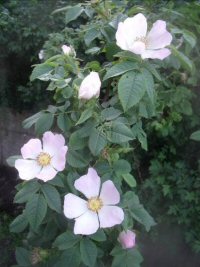
|
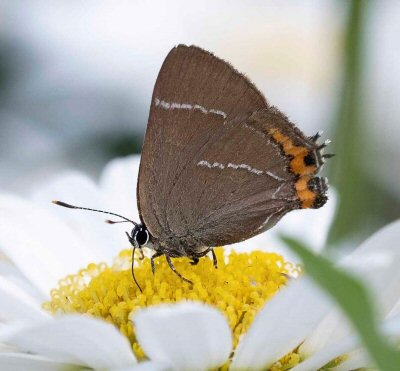
Photo: Bob Collis
The White-letter Hairstreak
A rare white-letter hairstreak, photographed by Bob Collis in Silverdale Road this July. Richard Beard, now resident in Canada, paid for a group of Elms to be planted on the Maiden Erlegh Nature Reserve (in memory of his father), for the specific purpose of attracting and hopefully re-establishing this butterfly species in Maiden Erlegh. It looks like it’s paid off!
|
|
Committee News
Announcements from the latest committee meeting.
The Committee
The Earley Environmental Group is run by a committee of local residents, all of whom volunteer their time and talents to ensure a well run and active group. However, since the ‘reshuffle’ at the AGM we have been short of a Secretary, so if you feel able to take minutes and handle any correspondence, please do get in touch via the website, or contact Bob Collis.
Newsletter: printed copies?
Since the newsletter was introduced, Oracle Corporation has kindly printed copies free of charge to enable the Group to distribute them to those without email and provide introductory material to visitors at our events. This aspect of Oracle’s support is to be withdrawn at the end of the year, and so the committee will be looking at alternative means of supply. If you currently receive a printed copy, please let us know if you would be willing to switch to PDF, so that we can gauge the future print run needed.
Veteran tree survey
Members of the EEG Committee joined Councillors from the ETC’s Veteran Tree Group on Saturday 23 July to locate the veteran trees around Maiden Erlegh Lake that are on the Wokingham District Veteran Tree Association database. The group will be looking at how to protect existing and new trees that are of significance in Earley, and at how to engage the public in appreciating the trees in their area.
|
Save Cash and Climate
John Booth
The following notes were prepared for the spring issue of this newsletter, but carried over for reasons of space.
At the end of February, the Intergovernmental Panel on Climate Change (IPCC) issued a major report on ‘Impacts, Adaptation and Vulnerability’. UN Secretary-General Antonio Guterres described the report as “an atlas of human suffering and a damning indictment of failed climate leadership,” warning that nearly half of humanity is in the climate danger zone and many ecosystems are at the point of no return.
A key point from the report is that ‘Net Zero’ by 2050 is not a sufficient target to prevent very serious consequences for humanity and the natural environment. Alok Sharma’s response was “We must urgently accelerate our efforts to keep 1.5 C in reach through revisiting and strengthening 2030 targets, delivering support, investment and employment opportunities.”
To address both rising energy bills and carbon emissions we should take progressively larger steps to reduce our use of fossil fuels. The Energy Savings Trust is one source of information.
Wokingham Borough Council promotes schemes to fund people who are eligible for ‘Help to Heat’. They are also looking at a scheme to offer improvements to homes with poor Energy Performance Certificates (D or below).
The International Energy Agency has produced a 10-point plan to cut oil use in transport – advocating measures such as lower speeds on highways and cheaper public transport.
|
|
Nature in Earley: 2023
– EEG’s community calendar still £5.00
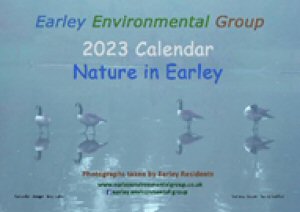
The EEG’s 2023 ‘Nature in Earley’ Calendar is now available. Many beautiful photos have been received from local photographers for inclusion in the EEG’s 4th calendar. Pages show images of wildflowers, birds, fungi and insects found in Earley, as well as great photos of the local green environment.
The format will again be A4 when folded, opening out to A3 at full size, and it comes an envelope.
The calendar will cost £5.00 with monies raised used to support the EEG’s activities. You can purchase calendars by emailing me.
Further information about where you can purchase calendars will be posted on the EEG’s Website.
Bob Collis, Calendar Editor.
|
|
Planning Matters
A round-up of developments that affect the land use and planning status of space in our area.
The EEG has been working on a proposal to establish a Green Corridor Network for Earley. The green corridor concept is based on the findings of a report published in 2010; Making Space for Nature: A Review of England’s Wildlife Sites and Ecological Network; otherwise known as the “Lawton Report”, named after Professor Sir John Lawton, who chaired the group that produced the report.
Swallows Meadow
The deadline for the developers to appeal against the planning decision has now passed, so it looks as though Swallows Meadow is safe for the moment.
Orchids on Verges
Sadly, Orchids growing on the verges of Lower Earley Way and at the Blackboy Roundabout have been mown in error. WBC’s attention has been drawn to this oversight and advisory ‘no mow’ signs are being prepared by the EEG for use next year.
A step too far!
An OAP hijacked a digger for three hours to stop roots being dug up to resurface a park play area. Lea Awbery, 66, said trees were being killed in Burghfield, Berkshire. The council said it is stopping disease”
((Metro, 14 July 2022)
|
Making Space for Nature
EEG’s Proposed Green Corridor Network
Bob Collis
The Lawton Report (as introduced left) looked at ways of better connecting England’s wildlife to strengthen ecological networks and encourage nature to thrive against the pressures of climate change and increased rural development. The report stated that ecological networks generally have five components, reflecting both existing and potential ecological importance and function. These are:
- Core areas of high nature conservation value which form the heart of the network. They contain habitats that are rare or important because of the wildlife they support or the ecosystem services they provide.
- Corridors and ‘Stepping-Stones’ that improve the functional connectivity between core areas, enabling species to move between them to feed, disperse, migrate or reproduce.
- Restoration areas where measures are planned to restore or create new high value areas (which will ultimately become ‘core areas’). They are often situated so as to complement, connect or enhance existing core areas.
- Buffer zones that closely surround core areas, restoration areas, ‘stepping-stones’ and ecological corridors, and protect them from adverse impacts from the wider environment.
- Sustainable Use areas within the wider landscape focussed on the sustainable use of natural resources and appropriate economic activities, together with the maintenance of ecosystem services.
The EEG has adapted this concept to develop a draft green corridor network linking Earley’s established core green spaces (natural and ‘mown’); such as the Maiden Erlegh Nature Reserve, Laurel Park, Pearman’s Copse Nature Reserve, Redhatch Copse and areas of Reading University; with recently proposed Local Green Spaces and the EEG’s proposal for a Lower Earley Local Nature Reserve. Stepping-stones linking these areas; comprising smaller parks and green spaces, as well as ‘back garden’ green routes, have then been identified as possible links to green areas within and outside Earley; areas such as to Highwood and Dinton Pastures. The aim of the map is to bring together all Earley’s natural green spaces linked by green corridors to form a network of natural habitats that can be protected and enhanced as a comprehensive body of ecological sites. Within these corridors, each green space and stepping-stone has a role to play in providing wildlife with habitats and routes, and Earley’s residents with valued leisure areas.
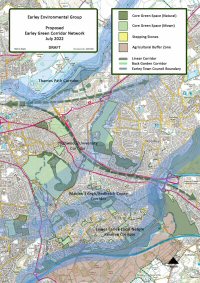
Click on the map to see a bigger version The proposal has already gained support from Earley Town Council, which in its Interim Earley Green Infrastructure Action Plan updated in April this year has included the proposed Green Corridor Map as the ‘hub of all Green Infrastructure policies’. This is a major step forward in protecting Earley’s green environment. The map is still under development, as there are many possible green areas still to be identified. The current draft shows many of Earley’s green spaces and also gives examples of possible green corridors that are being considered.
Bob Collis, EEG Chair
The ETC Green Infrastructure Plan is available on the Council’s website, and mentions the EEG several times. |
|
Litter picking
The EEG programme combines talks with walks and practical conservation. Here we report.

We estimate that 125 people took part in April’s Litter Pick, many of them from Hong Kong. Organized jointly with Earley Town Council and EASI, groups assembled in three locations: Instow Road, The Drive (off London Road) and at McDonald’s (below).

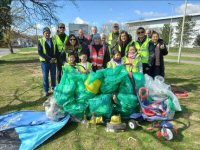
Congratulations …
… to Richard Trout, a former junior member of the EEG, on gaining his MSc in Environmental Biology & Conservation Management and graduating at Swansea University this summer.
|
Freely Fruity
Conceived, like many a good idea, in the pub (in this case, the Poacher at Sindlesham about a week before Lockdown). Ryan, Matt and James were inspired to grow fresh fruit and vegetables locally, motivated by the waste and unnecessary carbon footprint of importing produce, such as the nearly half a million tonnes of apples from New Zealand (with any surpluses going to landfill), or Argentinean pears plastic-packed in Thailand for sale in British supermarkets. We have so many local varieties, they argued, and could involve the community in local supply and distribution. Freely Fruity was a combination of terms that expressed their ambition and was not otherwise registered.
“We’re not farmers”, Ryan admitted; he was in IT, for instance, and Matt was a teacher. They were just three local blokes with an idea, who, between them, had about 100 years of residence in Earley. Their first attempt was to optimistically dig a trench for potatoes – all was well until it rained and the trench flooded. But they have gradually learned since.
In the early days, they cadged donations of plants, recalling collecting gifts from Caversham, and Matt accepting a collection of surplus tomato plants. Over the two years, however, they have greatly benefited from the support of Wokingham Borough Council and a range of formal and informal partnerships:
- CA Belcher – wholesale vegetables at cost
- Cocogreen – coir growing mats
- Red Design – website development
- Stihl – loan of a rotavator and supply of other implements at cost
- and a local builder who has lent heavy machinery when needed)
- Wokingham Borough Council – offers a water bowser, rather than relying on long hours with a hosepipe.
In an interesting aside, Ryan explained that on one occasion CA Belcher was unable to obtain courgette flowers on the wholesale market, needed as a delicacy under their contract to supply the l’Ortolan restaurant, so when Freely Fruit could provide, they were gratefully exchanged for a quantity of whole courgettes as a donation to food banks.
And so the project has grown from small beginnings to a successful registered charity over the past two years:
- 647 trees planted, with three main orchards at Dinton Pastures, Winnersh and Woosehill; at least six trees each at 17 schools (as five or more can be called an orchard!) and a living wall in Wokingham.
- 2.2 tonnes of produce given away, working with local charities such as Share, churches and food banks.
- Supporting Christmas dinners for the homeless in east Reading, donating vegetables (supplied at cost by CA Belcher) and giving their time as volunteers on the day.
- An education programme that benefits from Matt’s role as a teacher., including four groups of Little Growers.
- Website – designed by an old university friend of Matt’s – includes tips on growing vegetables such as spring onions from scraps, and seasonal recipes specially devised by a professional cookery writer to parallel Freely Fruity’s harvesting programme
It was an inspiring talk, with the speakers’ vision and abundant enthusiasm much in evidence. For more information, visit their website.
Edwin A.R. Trout
|
|
Birds in Earley
Programme organiser Charlotte Allchin recalls an early morning listening to birds in May.
In the list of birds heard on the walk, click on a name in red to hear that bird's song, call or other associated sound.
Blue Tit,
Blackbird,
Blackcap,
Black-headed Gull,
Canada Goose,
Carrion Crow,
Chiff Chaff,
Common Tern,
Coot,
Great Tit,
Great Spotted Woodpecker,
Herring Gull,
Jackdaw,
Lesser Black-backed Gull,
Magpie,
Mallard,
Moorhen,
Mute Swan,
Nuthatch,
Pied Wagtail,
Robin
Song Thrush,
House Sparrow,
Starling,
Stock Dove,
Wood Pigeon,
Wren.
Tufted ducklings
Tufted ducks visit Maiden Erlegh Lake occasionally, though they haven’t been for a while, so it was with surprise and delight that I saw not only a female in July, but one with eight tiny ducklings. When and whence did they arrive? Eight soon became six and then just one. Sadly, after a fortnight they’d all disappeared.
Two members have reported seeing a Little Egret on Maiden Erlegh Lake – a rare sighting indeed for this location.
Edwin A.R. Trout
|
Dawn Chorus Walk 2022
Charlotte Allchin
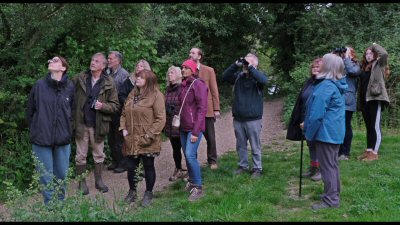
Recording of Blue Tit by Patrik Aberg Xeno-canto Recording of Blackbird by Niels Krabbe Xeno-canto Recording of Blackbird by Niels Krabbe Xeno-canto Recording of Blackcap by Mathias Ritschard Xeno-canto Recording of Black-headed Gull by Michał Jezierski Xeno-canto Recording of Canada Goose by Michał Jezierski Xeno-canto Recording of Carrion Crow by Stuart Fisher Xeno-canto Recording of Chiffchaff by Patrik Aberg Xeno-canto Recording of Common Tern by Marc Anderson Xeno-canto Recording of Coot by David Farrow Xeno-canto Recording of Great Tit by Stein O Nilsen Xeno-canto Recording of Great Spotted Woodpecker by Stuart Fisher Xeno-canto Recording of Herring Gull by Samuel Levy Xeno-canto Recording of Jackdaw by Patrik Aberg Xeno-canto Recording of Lesser Black-backed Gull by Guy Kirwan Xeno-canto Recording of Magpie by Stuart Fisher Xeno-canto Recording of Mallard by Matthias Feuersenger Xeno-canto Recording of Moorhen by Patrik Aberg Xeno-canto Recording of Mute Swan by Michał Jezierski Xeno-canto Recording of Nuthatch by Sander Bot Xeno-canto Recording of Pied Wagtail by Michał Jezierski Xeno-canto Recording of Robin by Patrik Aberg Xeno-canto Recording of Song Thrush by Patrik Aberg Xeno-canto Recording of House Sparrow by Michał Jezierski Xeno-canto Recording of Starling by Guy Kirwan Xeno-canto Recording of Stock Dove by Stuart Fisher Xeno-canto Recording of Woodpigeon by Simon Elliott Xeno-canto Recording of Wren by Patrik Aberg Xeno-canto In the early hours of Sunday May 1st 2022, a group of 14 left the Interpretation Centre and made their way around the nature reserve to listen to this most exquisite of song performances by the feathered community on the reserve.
Why do the birds sing in this way? The answer is that they want to impress, secure and successfully breed with a mate. They are also guarding their territories and ensuring the next generation of their line is secure.
The air is quietest at dawn and the sound of the chorus carries twenty times further than it does during the later parts of the day (information taken from the Woodland Trust).
Our walk was led by Robert Godden of Berkshire Ornithological Club, an ornithology expert, who travelled all the way from Sandhurst to lead the walk. He shared stories about the different birds as we went around the site and tips on how to tell the songs apart if the bird was not visible.
We saw or heard 27 different species as listed to the left.
The walk ended with a celebratory coffee and pastry back at the centre and further opportunity to discuss the species seen and share other wildlife related stories together for the first time since the first lockdown stopped all in person events from occurring!
We would love to thank Robert again for leading this walk and also Ken White and Ray Reedman that have led it in the past. Their generosity has allowed so many to better understand the wonderful world of birds and to be inspired by their enthusiasm and knowledge of the different characters we encountered along the way.
The number of woodland birds continues to fall year on year and the importance of doing what we can to try and maintain numbers increases. Ways to help range from simply keeping your cat indoors when birds are fledgling to volunteering your time to collect data in citizen science projects such as the annual Garden Birdwatch. If you would like to know more, please let us know.
You can hear dawn chorus birdsong recorded in Earley this year.
|
|
Maiden Erlegh LNR
What’s happening on Maiden Erlegh Lake and nature reserve
An Unexpected Visitor
I set off for a stretch around Maiden Erlegh Lake while the morning air was relatively cool – this was the Red Warning heat wave – and the sun was glowing gold. Squealing in Oak Wood opposite caught my attention. Foxes, or so I thought. This must be the fourth occasion I’d heard them in just over a week. I walked towards Beech Lane and round the sediment pond, pausing by the clearing where the barley bales had recently been installed. There, a rat was rummaging around in the grass for food, hunched in the open. I kept still so as not to disturb it, occasionally glancing surreptitiously left and right for the approach of passers-by. Then imagine my surprise when, to my left, I saw a deer standing in the middle of the path. I stared, and she looked back, hesitantly. Oh for my camera, as this was a perfect shot at close quarters! She started to retreat, uncertainly, before turning and melting into the vegetation around the inlet.
I could hear her moving behind the bushes. There were some legs just visible through the leaves, then a head ... Moments later, she burst from cover and bounded back along the path, seeking the safety of thicker vegetation. I loitered in the hope of another view; I even saw the turquoise flash of a kingfisher as it flew from its perch. I then completed my circuit, delighted with the morning’s serendipity.
"Gilbert White’s book, more than any other, has shaped our everyday view of the relations between humans and nature." (Richard Mabey, naturalist & biographer)
|
Gilbert White: an instinctive ecologist
Edwin Trout
The Revd. Gilbert White (1720-93), absentee ‘perpetual curate’ of Moreton Pinkney (Northants) and resident curate of Selborne (Hants), has been described as “the first ecologist”. He is of course famous for his book, The Natural History of Selborne, in which – through an edited series of letters to eminent naturalists of his day – he described his close observations of the wildlife of his native village, recorded on his estate over the changing seasons. He has been described as a man at one with his world.
His family home, The Wakes, is open to view and well worth a visit. It is delightful, a rambling series of additions to the initial sixteenth century dwelling purchased by his grandfather and extended again since Gilbert’s day. Now a museum held in trust, it is a monument to the man and his life’s work. Two break-fronted bookcases hold an impressive collection of all 300 editions of the Natural History, in a wide variety of imprints and bindings. And the original manuscript is proudly on show in the library. Excerpts indicate his observations of swifts, swallows and martens, and his practical experiments on a pet tortoise, Timothy. A highlight is the original desk in his study, upon which is a stuffed Crossbill dating from White’s lifetime.
Left: The Natural history of Selborne in manuscript. Right: White’s desk dated 1755
The relationship between White and other naturalists is explored, from his kinsmen Charles Butler, ‘the father of British bee-keeping’ and Thomas Barker, the meteorologist, to his correspondent the ornithologist Thomas Pennant. A later owner of the house was Thomas Bell, professor of Zoology at King’s College London and author of Stalk-eyed Crustacea of the British Isles. Also in the house, which serves as a museum to the Oates Collection too, are displays on Frank Oates the Victorian explorer of Central America and Southern Africa, as well as his more famous nephew, Captain Laurence Oates of the Antarctic.
Surrounding house are gardens, both culinary and ornamental, with meadows and woodland beyond. They may be visited independently of the house. Landscape features are employed to create vistas, and in one direction is a revolving hide, a recreation of the original inventively made from a disused port barrel.
In the church opposite, there are two commemorative windows to recall this clergyman and pioneering naturalist, one of which aptly depicts the theme of St Francis feeding the birds.
If this has whetted your appetite, I’d encourage you to visit; it’s a 45-minute drive from Earley.
The Wakes: Gilbert White’s House

Left: the later museum wing. Right: the original house
|
|
EEG Programme
We list the Group’s forthcoming walks and talks – fuller details are on the website.
2022 Programme
Walks and Talks
Please see the website and public notice boards for further details and updates.
6 August
Earley Green Fair
21-23 August
Wild About Reading
Details are on Facebook
2 September
Bat Walk
Greenfest
On Saturday 10 September, you might like to visit Green Fest at Hampstead Norreys in West Berkshire. It’s a free day out in the countryside, where you can see, interact and hear about sustainability solutions, visit the sustainable market (with over 40 lifestyle stalls) and take part in crafting activities, workshops, talks and much more.
More details on the village website.
Wednesday Volunteers
Meet at the Interpretation Centre at 9.30 on Wednesday mornings. You’ll be made very welcome.
|
Garden Surveys
Sheila collates some notable entries from members’ records
Gillian:
May Visits from holly blue, large white and red admiral butterflies. May 23rd – “fox seen crossing front lawn (pm).” (Foxes can scale 6ft fences. Attitudes to foxes are mixed, but surveys suggest the majority of people enjoy seeing them. Urban Foxes by Stephen Harris and Phil Baker recommended, also website https://foxproject.org.uk).
June ‘A quiet month’. June 27th - gt. spotted woodpecker on back lawn. (The young are sometimes thought to be middle spotted woodpeckers, but these are only found in France.)
Margaret:
April. 1st - six starlings. 17th - two greenfinches, “rarity here”.
May Visits from holly blue, large white and orange tip butterflies. May 3rd two common frogs “about 2 years old”.
June 1st one longtail tit “drinking and bathing”. 4 +I J gold finch, ‘enjoying the cornflowers’.
 Members of the EEG enjoying an informal Platinum Jubilee picnic in June, (followed by outdoor games), on the Maiden Erlegh Nature Reserve.
Members of the EEG enjoying an informal Platinum Jubilee picnic in June, (followed by outdoor games), on the Maiden Erlegh Nature Reserve.
Photo: Bob Collis
Thanks to ORACLE Corporation for reproducing our newsletter on recycled paper. Oracle is the world's second largest software company, situated at Thames Valley Business Park in Earley. Oracle UK adheres to the ISO14001 Environment Standard which confirms Oracle has considered and acted upon its environmental impact. As part of Oracle’s corporate social responsibility they support a number of local groups, including us. They have given us valuable support in reproducing the hard copies of our newsletter in colour, as well as printing posters and membership leaflets for us to distribute to libraries, schools etc.
|
|
|